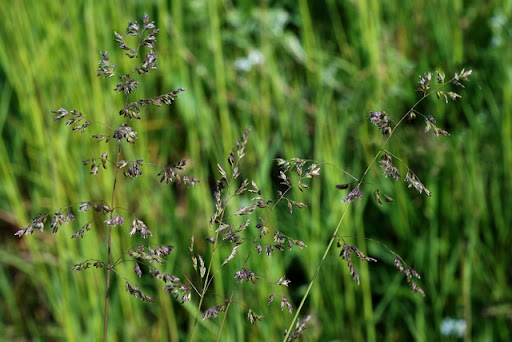Kentucky Bluegrass (Poa pratensis) in Grass North Carolina
Description:
Appearance:
- Kentucky Bluegrass has fine-textured, narrow blades that form a dense, carpet-like turf.
- It has a vibrant green color and a soft, velvety texture, making it a popular choice for lawns and landscapes.
Growth Habit:
- Kentucky Bluegrass spreads through above-ground rhizomes and tillers, forming a thick, sod-forming turf.
- It has a moderate growth rate and recovers quickly from damage caused by mowing, foot traffic, or other stresses.
Climate:
- Thrives in cool, temperate climates and performs best in regions with mild summers and cold winters.
- Kentucky Bluegrass is well-suited to the northern United States and other regions with similar climate conditions.
Sun Requirements:
- Prefers full sun but can tolerate partial shade, though it may become thin and sparse in heavily shaded areas.
- Performs best in areas with ample sunlight to support vigorous growth.
Drought Tolerance:
- Kentucky Bluegrass exhibits moderate drought tolerance but performs best with consistent moisture.
- Requires regular watering during dry periods to maintain optimal turf quality, making it less drought-tolerant than some other cool-season grasses.
Description:
Appearance:
- Kentucky Bluegrass has fine-textured, narrow blades that form a dense, carpet-like turf.
- It has a vibrant green color and a soft, velvety texture, making it a popular choice for lawns and landscapes.
Growth Habit:
- Kentucky Bluegrass spreads through above-ground rhizomes and tillers, forming a thick, sod-forming turf.
- It has a moderate growth rate and recovers quickly from damage caused by mowing, foot traffic, or other stresses.
Climate:
- Thrives in cool, temperate climates and performs best in regions with mild summers and cold winters.
- Kentucky Bluegrass is well-suited to the northern United States and other regions with similar climate conditions.
Sun Requirements:
- Prefers full sun but can tolerate partial shade, though it may become thin and sparse in heavily shaded areas.
- Performs best in areas with ample sunlight to support vigorous growth.
Drought Tolerance:
- Kentucky Bluegrass exhibits moderate drought tolerance but performs best with consistent moisture.
- Requires regular watering during dry periods to maintain optimal turf quality, making it less drought-tolerant than some other cool-season grasses.
Description
Kentucky Bluegrass (Poa pratensis) is a cool-season grass known for its fine texture, lush green color, and ability to form a dense, durable turf. It’s commonly used for lawns, parks, golf courses, and athletic fields in regions with cold winters and moderate summers.
Description:
Appearance:
- Kentucky Bluegrass has fine-textured, narrow blades that form a dense, carpet-like turf.
- It has a vibrant green color and a soft, velvety texture, making it a popular choice for lawns and landscapes.
Growth Habit:
- Kentucky Bluegrass spreads through above-ground rhizomes and tillers, forming a thick, sod-forming turf.
- It has a moderate growth rate and recovers quickly from damage caused by mowing, foot traffic, or other stresses.
Climate:
- Thrives in cool, temperate climates and performs best in regions with mild summers and cold winters.
- Kentucky Bluegrass is well-suited to the northern United States and other regions with similar climate conditions.
Sun Requirements:
- Prefers full sun but can tolerate partial shade, though it may become thin and sparse in heavily shaded areas.
- Performs best in areas with ample sunlight to support vigorous growth.
Drought Tolerance:
- Kentucky Bluegrass exhibits moderate drought tolerance but performs best with consistent moisture.
- Requires regular watering during dry periods to maintain optimal turf quality, making it less drought-tolerant than some other cool-season grasses.
Planting Instructions:
1. Site Preparation:
- Choose a planting site with well-drained soil and ample sunlight. Kentucky Bluegrass prefers fertile, loamy soil but can tolerate a wide range of soil types, including clay and sandy soils.
- Prepare the planting area by clearing the site of any existing vegetation, weeds, rocks, and debris
- Loosen the soil to a depth of 4 to 6 inches using a garden fork, tiller, or similar tool to improve soil structure and promote root growth.
2. Seeding:
- Kentucky Bluegrass is commonly established from seed. Choose a high-quality Kentucky Bluegrass seed blend suitable for your climate and site conditions.
- Sow the seed evenly across the prepared area using a broadcast spreader or by hand. The recommended seeding rate is typically 2 to 3 pounds of seed per 1,000 square feet for new lawns.
3. Seed-to-Soil Contact:
- Ensure good seed-to-soil contact by lightly raking the seeded area or gently rolling it with a lawn roller. This helps the seeds make contact with the soil, enhancing germination rates.
4. Watering:
- Keep the seeded area consistently moist until the grass establishes, usually within 2 to 3 weeks.
- Water lightly multiple times a day to prevent the soil from drying out. Once the grass is established, gradually reduce watering frequency but increase the amount of water applied to encourage deep root growth.
5. Fertilization:
- Apply a starter fertilizer at the time of planting to promote root development and establishment.
- After the grass has established, follow a regular fertilization schedule based on soil test recommendations or general guidelines for cool-season grasses.
6. Mowing:
- Begin mowing Kentucky Bluegrass when it reaches a height of 2 to 3 inches. Set the mower blade to a height of 1.5 to 2 inches and mow regularly to maintain the desired height.
- Kentucky Bluegrass can be mowed slightly shorter for a manicured appearance but should not be scalped, as this can stress the grass and increase susceptibility to pests, diseases, and drought
7. Maintenance:
- Kentucky Bluegrass requires regular maintenance to keep it healthy and attractive. This includes watering during periods of drought, occasional mowing to maintain a uniform height, and periodic overseeding to fill in bare spots and maintain density.
- Monitor the lawn for pests, diseases, and weeds, and take appropriate action as needed to preserve turf health and appearance.





